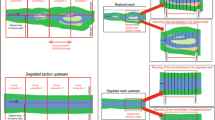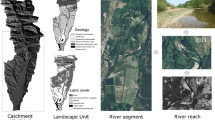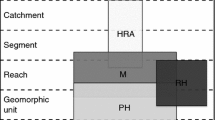Abstract
The Morphological Quality Index (MQI) and the Morphological Quality Index for monitoring (MQIm) have been applied to eight case studies across Europe with the objective of analyzing the hydromorphological response to various restoration measures and of comparing the results of the MQI and MQIm as a morphological assessment applied at the reach scale, with a conventional site scale physical-habitat assessment method. For each restored reach, the two indices were applied to the pre-restoration and post-restoration conditions. The restored reach was also compared to an adjacent, degraded reach. Results show that in all cases the restoration measures improved the morphological quality of the reach, but that the degree of improvement depends on many factors, including the initial morphological conditions, the length of the restored portion in relation to the reach length, and on the type of intervention. The comparison with a conventional site scale physical-habitat assessment method shows that the MQI and MQIm are best suited for the evaluation of restoration effects on river hydromorphology at the geomorphologically-relevant scale of the river reach.






Similar content being viewed by others
References
Arnaud F, Piégay H, Schmitt L, Rollet AJ, Ferrier V, Béal D (2015a) Geomorphology historical geomorphic analysis (1932–2011) of a by-passed river reach in process-based restoration perspectives: The Old Rhine downstream of the Kembs diversion dam (France, Germany). Geomorphology 236:163–177
Arnaud F, Staentzel C, Beisel JN, Piégay H, Grac C, Trémolières M, Combroux I, Schmitt L, Barillier A, Garnier A (2015b) Geomorphic and ecological monitoring of an experimental sediment reintroduction into the Rhine River downstream of the Kembs dam. Proceedings I.S. Rivers 2015
Beechie TJ, Sear DA, Olden JD, Pess GR, Buffington JM, Moir H, Roni P, Pollock MM (2010) Process-based principles for restoring river ecosystem. BioScience 60(3):209–222
Belletti B, Rinaldi M, Gurnell AM, Buijse AD, Mosselman E (2015a) A review of assessment methods for river hydromorphology. Environ Earth Sci 73:2079–2100
Belletti B, Rinaldi M, Comiti F, Nardi L, Mao L, Bussettini M (2015b) Development of a system for the classification of geomorphic units aimed at characterizing physical habitats and stream morphology. In: Angelopoulos N, Buijse AD et al. (ed), Proceedings of the International Conference on River and Stream Restoration “Novel Approaches to Assess and Rehabilitate Modified Rivers”. FP7 REFORM deliverable 7.5, pp 86–91
Belletti B, Rinaldi M, Bussettini M, Comiti F, Gurnell AM, Mao L, Nardi L, Vezza P (2017) Characterising physical habitats and fluvial hydromorphology: a new system for the survey and classification of river geomorphic units. Geomorphology 283:143–157
Brierley GJ, Fryirs KA (2005) Geomorphology and river management: applications of the river style framework. Blackwell, Oxford
Brierley GJ, Fryirs K (2009) Don’t fight the site: geomorphic considerations in catchment-scale river rehabilitation planning. Environ Manag 43(6):1201–1218
Brierley GJ, Reid H, Fryirs K, Trahan N (2010) What are we monitoring and why? Using geomorphic principles to frame eco-hydrological assessments of river condition. Sci Total Environ 408:2025–2033
Campana D, Marchese E, Theule JI, Comiti F (2014) Channel degradation and restoration of an Alpine river and related morphological changes. Geomorphology 221:230–241
Church M (2006) Bed material transport and the morphology of alluvial river channels. Annu Rev Earth Planet Sci 34:325–354
Clarke SJ, Bruce-Burgess L, Wharton G (2003) Linking form and function: towards an eco-hydromorphic approach to sustainable river restoration. Aquat Conserv: Mar Freshw Ecosyst 13:439–450
Comiti F (2012) How Natural Are Alpine Mountain Rivers? Evidence from the Italian Alps. Earth Surf Process Landf 37(7):693–707
Eeckout JPC, Hoitink AJF, De Brouwer JHF, Verdonschot PFM (2015) Morphological assessment of reconstructed lowland streams in the Netherlands. Adv Water Resour 81:161–171
Elosegi A, Flores L, Díez J (2011) The importance of local processes on river habitat characteristics: a Basque stream case study. Limnetica 30(2):183–196
Fortin MJ, Payette S, Marineau K (1999) Spatial vegetation diversity index along a postfire successional gradient in the northern boreal forest. Ecoscience 6:204–213
Friberg N (2014) Impacts and indicators of change in lotic ecosystems. WIREs Water 1:513–531
Friberg N, Baattrup-Pedersen A, Kristensen EA, Kronvang B, Larsen SE, Pedersen ML, Skriver J, Thodsen H, Wiberg-Larsen P (2014) The River Gelså restoration revisited: habitat specific assemblages and persistence of the macroinvertebrate community over an 11-year period. Ecol Eng 66:150–157
Fryirs KA (2015) Developing and using geomorphic condition assessments for river rehabilitation planning, implementation and monitoring. WIREs Water 2:649–667
González Del Tánago M, Gurnell AM, Belletti B, García de Jalón D (2016) Indicators of river system hydromorphological character and dynamics: understanding current conditions and guiding sustainable river management. Aquat Sci 78:35–55
Golfieri B, Surian N, Hardersen S (2018) Towards a more comprehensive assessment of river corridor conditions: a comparison between the Morphological Quality Index and three biotic indices. Ecol Indic 84:525–534
Göthe E, Timmermann A, Januschke K, Baattrup-Pedersen A (2015) Structural and functional responses of floodplain vegetation to stream ecosystem restoration. Hydrobiologia 769(1):1–14
Gurnell AM, Belletti B, Bizzi S, Blamauer B, Braca G, Buijse AD, Bussettini M, Camenen B, Comiti F, Demarchi L, García De Jalón D, González Del Tánago M, Grabowski RC, Gunn IDM, Habersack H, Hendriks D, Henshaw A, Klösch M, Lastoria B, Latapie A, Marcinkowski P, Martínez-Fernández V, Mosselman E, Mountford JO, Nardi L, Okruszko T, O’Hare MT, Palma M, Percopo C, Rinaldi M, Surian N, van de Bund W, Weissteiner C, Ziliani L (2016a) A multi-scale hierarchical framework for developing understanding of river behaviour. Aquat Sci 78:1–16
Gurnell AM, Rinaldi M, Buijse AD, Brierley G, Piégay H (2016b) Hydromorphological frameworks: emerging trajectories. Aquat Sci 78:135–138
Haase P, Hering D, Jähnig SC, Lorenz AW, Sundermann A (2013) The impact of hydromorphological restoration on river ecological status: a comparison of fish, benthic invertebrates, and macrophytes. Hydrobiologia 704:475–488
Habersack H, Piégay H (2007) Challenges in river restoration in the Alps and their surrounding areas. In: Habersack H, Piégay H, Rinaldi M (ed) Gravel-bed River 6: From process understanding to river restoration. Elsevier, Amsterdam, p 703–737
Hering D, Aroviita J, Baattrup-Pedersen A, Brabec K, Buijse T, Ecke F, Friberg N, Gielczewski M, Januschke K, Köhler J, Kupilas B, Lorenz AW, Muhar S, Paillex A, Poppe M, Schmidt T, Schmutz S, Vermaat J, Verdonschot PFM, Verdonschot RCM, Wolter C, Kail J (2015) Contrasting the roles of section length and instream habitat enhancement for river restoration success: a field study of 20 European restoration projects. J Appl Ecol 52(6):1518–1527
Jähnig SC, Lorenz AW, Hering D (2008) Hydromorphological parameters indicating differences between single-and multiple-channel mountain rivers in Germany, in relation to their modification and recovery. Aquat Conserv: Mar Freshw Ecosyst 18:1200–1216
Jähnig SC, Brunzel S, Gacek S, Lorenz AW, Hering D (2009) Effects of re-braiding measures on hydromorphology, floodplain vegetation, ground beetles and benthic invertebrates in mountain rivers. J Appl Ecol 46:406–416
Jähnig SC, Brabec K, Buffagni A, Erba S, Lorenz AW, Ofenboeck T, Verdonschot PFM, Hering D (2010) A comparative analysis of restoration measures and their effects on hydromorphology and benthic invertebrates in 26 central and southern European rivers. J Appl Ecol 47:671–680
Jähnig SC, Lorenz AW, Lorenz RRC, Kail J (2013) A comparison of habitat diversity and interannual habitat dynamics in actively and passively restored mountain rivers of Germany. Hydrobiologia 712:89–104
Januschke K, Brunzel S, Haase P, Hering D (2011) Effects of stream restorations on riparian mesohabitats, vegetation and carabid beetles. Biodivers Conserv 20:3147–3164
Januschke K, Jähnig SC, Lorenz AW, Hering D (2014) Mountain river restoration measures and their success(ion): effects on river morphology, local species pool, and functional composition of three organism groups. Ecol Indic 38:243–255
Kail J, Hering D (2005) Using large wood to restore streams in Central Europe: potential use and likely effects. Landsc Ecol 20:755–772
Kail J, Brabec K, Januschke K, Poppe M (2015) The effect of river restoration on fish, macroinvertebrates and macrophytes: a meta-analysis. Ecol Indic 58:311–321
Knighton D (1998) Fluvial forms and processes: a new perspective. Arnold, London
Kristensen EA, Thodsen H, Dehli B, Quiroga Kolbe PE, Glismand L, Kronvang B (2013) Comparison of active and passive stream restoration: effects on the physical habitats. Geogr Tidsskr-Dan J Geogr 113(2):109–120
Kristensen EA, Kronvang B, Wiberg-Larsen P, Thodsen H, Nielsen C, Amor E, Friberg N, Pedersen ML, Baattrup-Pedersen A (2014) 10 years after the largest river restoration project in Northern Europe: hydromorphological changes on multiple scales in River Skjern. Ecol Eng 66:141–149
Laub BG, Baker DW, Bledsoe BP, Palmer MA (2012) Range of variability of channel complexity in urban, restored and forested reference streams. Freshw Biol 57:1076–1095
Marttila M, Kyllönen K, Karjalainen TP (2016) Social success of in-stream habitat improvement: from fisheries enhancement to the delivery of multiple ecosystem services. Ecol Soc 21(1):4. https://doi.org/10.5751/es-08118-210104
Massey W, Biron PM, Choné G (2017) Impacts of river bank stabilization using riprap on fish habitat in two contrasting environments. Earth Surf Process Landf 42(4):553–696. https://doi.org/10.1002/esp.4010
Morandi B, Piégay H (2011) River restoration experiences on the web: operational outcomes and perspectives. Nat Sci Sociétés 19:224–235
Morandi B, Piégay H, Lamouroux N, Vaudor L (2014) How is success or failure in river restoration projects evaluated? Feedback from French restoration projects. J Environ Manag 137:178–188
Mosselman E, Angelopoulos N, Belletti B, Brouwer R, Gurnell AM, Friberg N, Kail J, Reichert P, Geerling G (2015) Guidance and decision support for cost-effective river and floodplain restoration and its benefits. Deliverable 6.3 of REFORM (REstoring rivers FOR effective catchment Management), a Collaborative project (large-scale integrating project) funded by the European Commission within the 7th Framework Programme under Grant Agreement 282656, p 26
Muhar S, Jungwirth M, Unfer G, Wiesner C, Poppe M, Schmutz S, Hohensinner S, Habersack H (2007) Restoring riverine landscapes at the Drau River: successes and deficits in the context of ecological integrity. In: Habersack H, Piégay H, Rinaldi M (ed) Gravel-bed rivers VI: From process understanding to river restoration. Elsevier, Amsterdam, p 779–803
Muhar S, Januscke K, Kail J, Poppe M, Schmutz S, Hering D, Buijse AD (2016) Evaluating good-practice cases for river restoration across Europe: context, methodological framework, selected results and recommendations. Hydrobiologia 769(1):3–19
Nardi L, Rinaldi M, Belletti B, Comiti F, Golfieri B, Marchese E, Surian N, Brabec K, Giełczewski M, Hellsten S, Kaufman S, Marcinkowski P, Muhar S, Okruszko T, Paillex A, Poppe M, Rääpysjärvi J, Schirmer M, Stelmaszczyk M (2015) Application of the Morphological Quality Index (MQI) to European case studies. In: Angelopoulos N, Buijse AD et al. (ed), Proceedings of the International Conference on River and Stream Restoration “Novel Approaches to Assess and Rehabilitate Modified Rivers”. FP7 REFORM deliverable 7.5, pp 143–149
Newson MD, Large ARG (2006) ‘Natural’ rivers, ‘hydromorphological quality’ and river restoration: a challenging new agenda for applied fluvial geomorphology. Earth Surf Process Landf 31:1606–1624
Ollero OA, Ballarín FD, Díaz BE, Mora MD, Sánchez FM, Acín NV, Echeverría AMT, Granado GD, Ibisate GA, Sánchez GL, Sánchez GN (2007) Un indice hydrogeomorfologico (IHG) para la evaluacion del estado ecologico de sistemas fluviales. Geographicalia 52:113–141
Osenberg CW, Sarnelle O, Cooper SD (1997) Effect size in ecological experiments: the application of biological models in meta-analysis. Am Nat 150:798–812
Palmer MA, Allan JD, Meyer JL, Bernhardt ES (2007) River restoration in the twenty-first century: data and experiential future efforts. Restor Ecol 15:472–481
Pasternack GB (2013) Geomorphologist’s guide to participating in river rehabilitation. In: Shroder J, Butler DR, Hupp CR (ed) Treatise on geomorphology. Academic Press, San Diego, CA, p 843–860.
Poppe M, Kail J, Aroviita J, Stelmaszczyk M, Gielczewski M, Muhar S (2016) Assessing restoration effects on hydromorphology in European mid-sized rivers by key hydromorphological parameters. Hydrobiologia 769(1):21–40
Richards K, Brasington J, Hughes F (2002) Geomorphic dynamics of floodplains: ecological implications and a potential modelling strategy. Freshw Biol 47:559–579
Rinaldi M, Wyżga B, Gurnell AM, Dufour S, Bertoldi W (2013a) River processes and implications for fluvial ecogeomorphology: a European perspective. In: Shroder J, Butler DR, Hupp CR (ed) Treatise on geomorphology. Academic Press, San Diego, CA, p 37–52
Rinaldi M, Surian N, Comiti F, Bussettini M (2013b) A method for the assessment and analysis of the hydromorphological condition of Italian streams: the Morphological Quality Index (MQI). Geomorphology 180-181:96–108
Rinaldi M, Surian N, Comiti F, Bussettini M (2015a) A methodological framework for hydromorphological assessment, analysis and monitoring (IDRAIM) aimed at promoting integrated river management. Geomorphology 251:122–136
Rinaldi M, Nardi L, Belletti B, Bizzi S, Brabec K, Comiti F, Demarchi L, Giełczewski M, Golfieri B, Habersack H, Hellsten S, Kaufman S, Klösch M, Marchese E, Marcinkowski P, Muhar S, Okruszko T, Paillex A, Poppe M, Rääpysjärvi J, Seppo H, Schirmer M, Stelmaszczyk M, Surian N, van de Bund W (2015b) Final report on methods, models, tools to assess the hydromorphology of rivers. Deliverable 6.2, Part 5, of REFORM (REstoring rivers FOR effective catchment Management), a Collaborative project (large-scale integrating project) funded by the European Commission within the 7th Framework Programme under Grant Agreement 282656, p 93
Rinaldi M, Surian N, Comiti F, Bussettini M, Belletti B, Nardi L, Lastoria B, Golfieri B (2015c) Guidebook for the evaluation of stream morphological conditions by the Morphological Quality Index (MQI). Deliverable 6.2, Part 3, of REFORM (REstoring rivers FOR effective catchment Management), a Collaborative project (large-scale integrating project) funded by the European Commission within the 7th Framework Programme under Grant Agreement 282656, p 161
Rinaldi M, Belletti B, Bussettini M, Comiti F, Golfieri B, Lastoria B. Marchese E, Nardi L, Surian N (2016a) New tools for the hydromorphological assessment and monitoring of European streams. J Environ Manag. https://doi.org/10.1016/j.jenvman.2016.11.036
Rinaldi M, Gurnell AM, González Del Tánago M, Bussettini M, Hendriks D (2016b) Classification of river morphology and hydrology to support management and restoration. Aquat Sci 78:17–33
Schmutz S, Kremser H, Melcher A, Jungwirth M, Muhar S, Waidbacher H, Zauner G (2014) Ecological effects of rehabilitation measures at the Austrian Danube: a meta-analysis of fish assemblages. Hydrobiologia. 729:49–60
Schmutz S, Jurajda P, Kaufmann S, Lorenz A, Muhar S, Paillex A, Poppe M, Wolter C (2015) Response of fish assemblages to hydromorphological restoration in central and northern European rivers. Hydrobiologia. https://doi.org/10.1007/730s10750-015-2354-6
Sear DA, Wheaton JM, Darby SE (2008) Uncertain restoration and the role of geomorphology. In: Habersack H, Piégay H, Rindaldi M (eds), Gravel-bed rivers IV: From process understanding to river restoration, vol 11. Elsevier, Amsterdam, pp 739–760
Shannon CE, Weaver W (1949) The mathematical theory of communication. The University of Illinois Press, Urbana
Viles HA, Naylor LA, Carter NEA, Chaput D (2008) Biogeomorphological disturbance regimes: progress in linking ecological and geomorphological systems. Earth Surf Process Landf 33:1419–1435
Ward JV, Tockner K, Uehlinger U, Malard F (2001) Understanding natural patterns and processes in river corridors as the basis for effective river restoration. Regul River Res Manag 17:311–323
Wohl E, Merritts DJ (2007) What is a natural river? Geogr Compass 1:871–900
Wohl E, Lane SN, Wilcox AC (2015) The science and practice of river restoration. Water Resour Res 51:5974–5997
Acknowledgements
The work incorporated in this paper was funded through the European Union’s FP7 programme under Grant Agreement No. 282656 (REFORM). The present study was developed within the context of Deliverable D6.2 of the REFORM programme. The authors sincerely thank the Associate Editor, Angus Webb, and two anonymous reviewers for their precious comments and feedback.
Author information
Authors and Affiliations
Corresponding author
Ethics declarations
Conflict of Interest
The authors declare that they have no competing interests.
Rights and permissions
About this article
Cite this article
Belletti, B., Nardi, L., Rinaldi, M. et al. Assessing Restoration Effects on River Hydromorphology Using the Process-based Morphological Quality Index in Eight European River Reaches. Environmental Management 61, 69–84 (2018). https://doi.org/10.1007/s00267-017-0961-x
Received:
Accepted:
Published:
Issue Date:
DOI: https://doi.org/10.1007/s00267-017-0961-x




